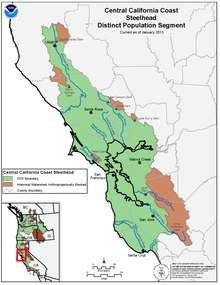Steelhead trout
Steelhead trout is a name given to the anadromous form of the coastal rainbow trout (Oncorhynchus. m. irideus) or redband trout (O. m. gairdneri).[1][2] The steelhead are native to freshwater and ocean environments across North America, but have been introduced to every other continent except Antarctica. Steelhead use aquatic obstructions like vegetation, boulders, and fallen trees as protection.[3] Steelhead migrate to spawn during the summer months and the winter months.[3]
.jpeg)
Description
The freshwater form of the steelhead trout is the rainbow trout. The difference between these forms of the species is that steelhead migrate to the ocean and return to freshwater tributaries to spawn, whereas rainbow trout do not leave freshwater. Steelhead are also larger and less colorful than rainbow trout. Steelhead can weigh up to 55 pounds (26 kg) and reach 45 inches (114 cm) in length. They can live up to 11 years and spawn multiple times.[3] The body of the steelhead trout is silvery and streamlined with a rounder head. There are black dots and a red or pink stripe running down the side of the fish horizontally. This silver color and round head is what gives the steelhead its name.[3]
A number of distinct population segments of steelhead trout are endangered or threatened across the United States, mostly caused by the blocking of waterways by the construction of dams. Human interaction has had considerable consequences on reducing the population of steelhead trout.[4]
When the fish are newly hatched, they feed on zooplankton and small insects. Once mature, the fish eat a large variety of food sources: fish eggs, insects, crustaceans, mollusks, small fish, and terrestrial animals.[3]
Spawning
During spawning, the fish will lay their eggs on gravel bottoms of freshwater tributaries. The female digs out a hole called a redd. The preferred depth for steelhead spawning is 6 in to 14 in.[5] She then lays the eggs, and a male fertilizes them. The females will then cover the eggs with the gravel. Depending on the size of the female she may lay up to 9,000 eggs. The females then buries the eggs in a foot of gravel. The eggs remain in the gravel until they hatch. Unlike salmon who can only spawn once, steelhead may return to the ocean, and come back up streams several times for spawning season.
Threats
A number of distinct population segments of steelhead trout are endangered or threatened across the United States, This is because of humanization, such as agriculture, mining, forestry, and urbanization, all thought to block, limit, and degrade waterways for steelhead habitat.[6] During droughts or low water seasons recreation fishing causes a decrease in steelhead.[7]
Conservation
There have been several conservation programs created since the near extinction of the steelhead in the 1940s. The reduction in population is mainly due to manmade obstructions within river systems. This is usually caused by dams blocking access, or humans changing the river landscape for recreation and access to water. It is estimated that only 500 steelhead trout return to the Southern California watersheds. However, in other areas of the United States, steelhead can be seen as pests because they are an invasive species to the environment.[4]

Steelhead trout are endangered within the area of:
- Southern California DPS
Steelhead trout are threatened within the areas of:[3]
- California Central Valley DPS
- Central California coast DPS
- Lower Columbia River DPS
- Middle Columbia River
- Northern California DPS
- Puget Sound DPS
- Snake River Basin DPS
- South-Central California coast DPS
- Upper Columbia River DPS
- Upper Willamette River DPS
References
- Behnke, Robert J. (2002). "Rainbow and Redband Trout". Trout and Salmon of North America. Tomelleri, Joseph R. (illustrator). New York: The Free Press. p. 67. ISBN 978-0-7432-2220-4.
- "Steelhead Trout". NOAA Fisheries. National Oceanic and Atmospheric Association.
- "Rainbow Trout and Steelhead". The National Wildlife Federation.
- "Southern Steelhead: A Story of Recovery". California Trout.
- "Steelhead". www.calfish.org. Retrieved 2019-11-17.
- Thorp, James H. (2011). Field guide to freshwater invertebrates of North America. Rogers, D. Christopher. Burlington, MA: Academic Press. ISBN 9780123814265. OCLC 658117143.
- www.sierraforestlegacy.org https://www.sierraforestlegacy.org/. Retrieved 2019-11-17. Missing or empty
|title=(help)